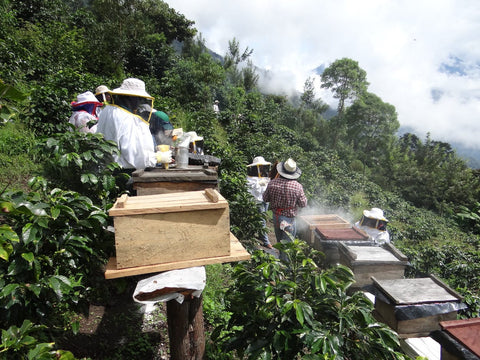First Published - December 14, 2012
Micromills
A micromill can be as small and compact as this one, located at Beneficio don Sergio. This machine depulps the coffee, and removes the fleshy layer so that coffee is ready to be dried in the sun on raised or “African” drying beds.
The mill allows producers to process three types of coffee; red honey, yellow honey and “fully washed” (meaning that it’s what is called machine-assisted wet processing.) Each type is determined by the amount of pulp retained on the bean. The greater the amount of pulp that is left, dries to a leave red sticky coating on the surface of the bean – it looks like Sugar Puffs breakfast cereal. Having their own micromill means that the producers retain quality control and can craft their coffee to create what specialty roasters want.
This is what the inside of the micromill looks like. It contains a a pulping machine which removes the skin of the fruit and a demucilage machine. After removing the skin, this depulper takes off as much of the fruity mucilage layer as required. Removing mucilage by machine is easier and more predictable than removing it by fermenting and washing. Low-water useage machines make the process less water intensive and more environmental friendly.
Fermentation is not used to separate the bean from the remainder of the pulp (as in done in for example washed coffees in Guatemala); rather, this is done through mechanical scrubbing. After removing the mucilage the coffee is ready to be dried.
Dry Mills
This is an example of a dry mill. Once beans are dried, it is called “parchment” coffee. To process parchment into the green beans ready for roasting, all of the layers need to be removed from the beans (this process is called hulling). Occasionally, beans may be polished in a machine designed to remove that last little bit of silver skin.
Beans are then graded and sorted, first by size, then by density. Beans are sorted by hand and mechanically as they pass by on a conveyor belt or by an air jet that separates lighter (inferior) beans from heavier ones. There are also machines with an infrared eye that detect the colour of the bean, separating inferior black beans. Union buys only Specialty grade quality beans. Secondary quality coffee might go to commodity or national markets. When producers process the beans themselves, they can monitor and craft the quality and don’t have to worry about inferior beans from other outside farms being added to their production.
Wet Mills
This is a depulper at Don Cesar de Leon’s mill in La Libertad, Guatemala. Coffee must be depulped to remove the skin and fruit surrounding the bean. Some producers use motorized depulpers where others need to depulp by hand. When the skin is removed, unwashed parchment coffee goes through a sieve to separate beans that are not depulped correctly or have another defect. These cherries are collected in the blue basket.
Coffee needs to be processed the same day that’s it’s picked. Pickers can work from around 6:00am until 4:00pm, then have to start the processing if there isn’t enough labour. If there is a lot of coffee, this means that there is work until late at night! After depulping, the beans are fermented in a fermentation tank. The fermentation process should be watched carefully but usually takes around 24 hours depending upon weather conditions.
The mucilaginous pulp is removed by a fermentation stage that breaks down the mucilage by enzymatic activity to produce beans which have a rough surface. Care needs to be taken to control the correct length of time for this stage which is determined mostly by environmental temperature; too long leads to over-fermentation and negative attributes in the cup. After fermentation beans are washed in clean water to produce “squeaky clean” parchment coffee; rubbing a handful of beans together creates a squeaky sound because all the slimy mucilage has been removed. After that the coffee is washed in these troughs, called correteos.
Manual depulping
The red and yellow coffee cherry skins you see here are dried to be used as organic fertilizer for coffee plants or garden crops. The blue basket contains undried parchment that still needs to be fermented and washed to remove the honey. Manual depulpers like this, process much less volume per day than the mechanical machines that have a motor or dynamo.








